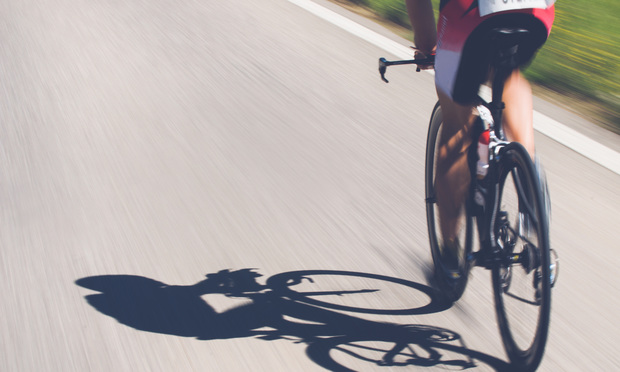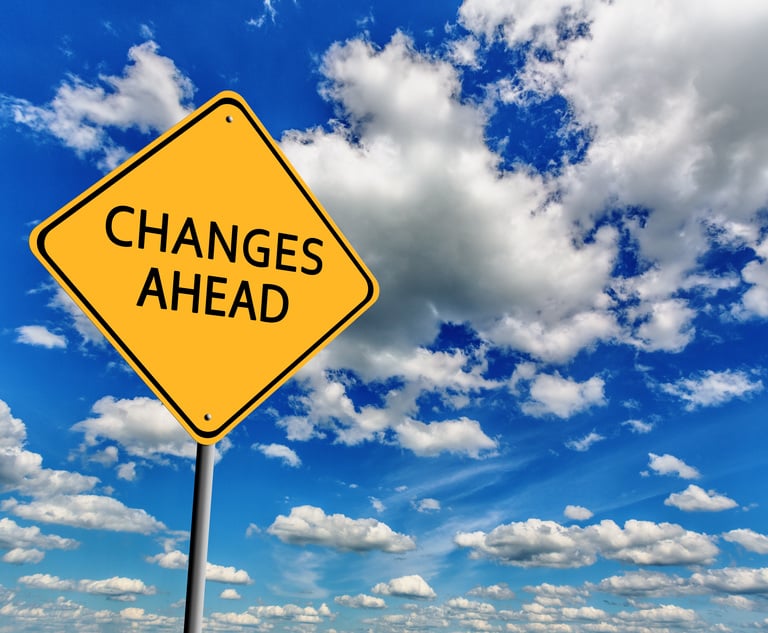Accelerate Uphill: Succeeding in the Tough Times
There are a significant number of firms that have been enjoying the downhill slope of the legal market for quite some time. However, over the last 2-3 years, many firms have been steadily pedaling and not looking up from their handlebars as often as they should. Now, with a looming slowdown in the economy, many lawyers are staring straight at an intimidating, uphill climb for the foreseeable future.
April 30, 2020 at 06:11 PM
7 minute read
 Speedy shadow – A cyclist at top speed on the triathlon race.
Speedy shadow – A cyclist at top speed on the triathlon race.
When a Tour de France competitor comes upon a hill that would make even a resilient goat need counseling afterward, he has three choices. He can conserve energy until he reaches the top, try to continue at the same pace as before, or accelerate uphill. What do you think his strategy should be?
Champions attack the uphill. While everyone may want to win the race, those that employ the wrong tactics and strategies will be struggling to finish it. Your position on the other side of the hill, and the long flat stretches that follow, are determined with each pedal stroke on the way up. What can we apply from cycling strategy to how law firms should be reacting to the economic, human, and emotional upheaval related to the COVID-19 crisis?
There are a significant number of firms that have been enjoying the downhill slope of the legal market for quite some time. This downhill slope is a metaphor for the relative ease it has been to continue to grow profits year over year, which is similar to a competitive cyclist coasting down a steep hill. It does not mean they are not working hard, but most people would agree that trying to build a practice in an expanding economy is not as arduous as one where clients are under stress and being conservative with their choices.
However, over the last 2-3 years, many firms have been steadily pedaling and not looking up from their handlebars as often as they should. Clients making demands for more transparency, predictability, and cost control were early warning signs of an increased incline. Losses of key talent, disproportionally weighted towards diverse and female lawyers, due to antiquated recruitment policies and rigid career paths were more portents of disruption. New, unconventional competitors such as ALSPs, LPOs, as well as a growing in-house counsel bench, showed that clients were starting to take action even when law firms wouldn't.
However, with a looming slowdown in the economy, many lawyers are staring straight at an intimidating, uphill climb for the foreseeable future. What is your strategy? Should you conserve energy until you get to the top by cutting back on technology and business development time and expenses? Or, should you accelerate uphill and invest in business development and the infrastructure that makes it possible at scale? For the answer, let's go back to our metaphor to show why a champion cyclist pedaling uphill is a scientifically proven strategy.
Most consistently high performers have won more than their fair share of contests. So, it is reasonable to think that they choose not to do things the hard way just for the extra challenge. They employ strategies that are proven time and time again.
Three things are working against you when cycling: rolling resistance, air resistance, and gravity. When going uphill, air resistance is not a concern, so drafting to reduce fighting against the wind is less effective. Rolling resistance is consistent at the elite level. Since gravity is the main issue while climbing, it favors the smaller riders and the ones with the highest aerobic efficiency and lean body mass. Hills are the great equalizer. The perfect approach, according to David Swain at the Wellness Institute and Research Center at Old Dominion University, "Overall performance is enhanced by using a variable power strategy: increasing effort slightly on uphills and compensating with decreased effort on downhills." [Swain, D.P. Cycling: Uphill and Downhill. In: Encyclopedia of Sports Medicine and Science, T.D. Fahey (Editor). Internet Society for Sport Science: http://sportsci.org 6 Nov 1998.]
Champions know that extensive research has proven that cyclists who are trying to come out ahead, not just finish, must accelerate uphill. The main reason is that more time is added during the climb than can be reduced on the descent. Everyone can go fast on the downhill, especially the larger riders that have more strength and weight. Lawyers and law firms are subject to the same rules. The larger firms have more resources and people and are harder to overtake during times of plenty (the downhill). Thus, it is competitively advantageous to accelerate uphill and make up any gaps in profitability when others may be coasting, hesitating, or just being lazy.
First, forget the 3- or 5-year strategy defined by what the firm would like to be one day. What a firm wants based on future financial goals and aspirations is irrelevant. What the COVID-19 crisis shows us is that firms with a strategy based on speed, agility, and quickness are the ones that will break to the front. Your plan now and in the years to come is adaptability, agile teams, and change management.
Second, resources (time, money, and attention) are finite, so firms need to invest in technology and business development initiatives that are focused on small groups of core contacts and have a measurable return on investment. The technology exists today to identify these people down to the individual. Advancements in technology enable lawyers to spend more time building loyalty as opposed to general awareness. You should be visiting and talking with your most profitable clients instead of broad prospects more than ever. Like a cyclist using a heart rate monitor or other digital training aid, you should be taking advantage of the latest technology to do so.
Third, extreme focus and collaboration are essential. Winners of the legal industry race will be using technology and digital strategies to be able to assemble multi-disciplinary teams to solve business problems. When a client is struggling to stay afloat, they need real estate, employment, tax, logistics, financial, and endless other experts to continue serving their clients. Leveraging "teams of teams" that are malleable and liquid is how the Big 4 operates. Law firms risk losing goodwill, and perhaps future market share, to them if firms treat client demand as isolated legal matters.
Variable power strategy means you gain ground and overtake your competitors on the uphill slope. It has demonstrated that it results in the fastest times. The steeper the hill, the more effective the strategy is. The same holds for lawyers and law firms facing a slowdown in the economy.
However, being a large firm does not mean they cannot act like a smaller, more agile one. Slowdowns favor the nimble firm or adaptable lawyer. According to the study mentioned above, "…large cyclists can achieve greater downhill speeds, but overall performance still favors smaller cyclists on hilly courses." In other words, those that can quickly adapt to the change in the course have the advantage over the hulking megafirm that has to carry all that weight uphill.
In full disclosure, this is a rewrite of a blog post I wrote in the past: March 4, 2009. In studying high performers in business, sport, military, astronauts, and other high-stress domains with extreme consequences, I have found this to be a common distinction between those that come out ahead in tough circumstances and those that don't. Looking back, the firms that stood up on the pedals in 2009 and accelerated uphill know it works. The ones that didn't might not have even finished the race. We all have the same resistance at the moment. How we choose to deal with it is entirely up to you.
 Darryl Cross is an ALM Fellow, legal technology executive, and high-performance team coach with over 22 years of experience advising lawyers and business professionals in the legal industry. He is also a Master Fitness Trainer certified by the National Academy of Sports Medicine and resides in Washington, D.C.
Darryl Cross is an ALM Fellow, legal technology executive, and high-performance team coach with over 22 years of experience advising lawyers and business professionals in the legal industry. He is also a Master Fitness Trainer certified by the National Academy of Sports Medicine and resides in Washington, D.C.
This content has been archived. It is available through our partners, LexisNexis® and Bloomberg Law.
To view this content, please continue to their sites.
Not a Lexis Subscriber?
Subscribe Now
Not a Bloomberg Law Subscriber?
Subscribe Now
NOT FOR REPRINT
© 2025 ALM Global, LLC, All Rights Reserved. Request academic re-use from www.copyright.com. All other uses, submit a request to [email protected]. For more information visit Asset & Logo Licensing.
You Might Like
View All
Empowering Your Lawyers: A Marketing Team’s Guide to Achieving Goals and Fostering Lawyer Satisfaction
9 minute read
Change Is Coming in the Trump Era. For Big Law, Change Is Already Here
6 minute read

'If the Job Is Better, You Get Better': Chief District Judge Discusses Overcoming Negative Perceptions During Q&A
Trending Stories
- 1Big Law Firms Sheppard Mullin, Morgan Lewis and Baker Botts Add Partners in Houston
- 2Lack of Jurisdiction Dooms Child Sex Abuse Claim Against Archdiocese of Philadelphia, says NJ Supreme Court
- 3DC Lawsuits Seek to Prevent Mass Firings and Public Naming of FBI Agents
- 4Growth of California Firms Exceeded Expectations, Survey of Managing Partners Says
- 5Blank Rome Adds Life Sciences Trio From Reed Smith
Who Got The Work
J. Brugh Lower of Gibbons has entered an appearance for industrial equipment supplier Devco Corporation in a pending trademark infringement lawsuit. The suit, accusing the defendant of selling knock-off Graco products, was filed Dec. 18 in New Jersey District Court by Rivkin Radler on behalf of Graco Inc. and Graco Minnesota. The case, assigned to U.S. District Judge Zahid N. Quraishi, is 3:24-cv-11294, Graco Inc. et al v. Devco Corporation.
Who Got The Work
Rebecca Maller-Stein and Kent A. Yalowitz of Arnold & Porter Kaye Scholer have entered their appearances for Hanaco Venture Capital and its executives, Lior Prosor and David Frankel, in a pending securities lawsuit. The action, filed on Dec. 24 in New York Southern District Court by Zell, Aron & Co. on behalf of Goldeneye Advisors, accuses the defendants of negligently and fraudulently managing the plaintiff's $1 million investment. The case, assigned to U.S. District Judge Vernon S. Broderick, is 1:24-cv-09918, Goldeneye Advisors, LLC v. Hanaco Venture Capital, Ltd. et al.
Who Got The Work
Attorneys from A&O Shearman has stepped in as defense counsel for Toronto-Dominion Bank and other defendants in a pending securities class action. The suit, filed Dec. 11 in New York Southern District Court by Bleichmar Fonti & Auld, accuses the defendants of concealing the bank's 'pervasive' deficiencies in regards to its compliance with the Bank Secrecy Act and the quality of its anti-money laundering controls. The case, assigned to U.S. District Judge Arun Subramanian, is 1:24-cv-09445, Gonzalez v. The Toronto-Dominion Bank et al.
Who Got The Work
Crown Castle International, a Pennsylvania company providing shared communications infrastructure, has turned to Luke D. Wolf of Gordon Rees Scully Mansukhani to fend off a pending breach-of-contract lawsuit. The court action, filed Nov. 25 in Michigan Eastern District Court by Hooper Hathaway PC on behalf of The Town Residences LLC, accuses Crown Castle of failing to transfer approximately $30,000 in utility payments from T-Mobile in breach of a roof-top lease and assignment agreement. The case, assigned to U.S. District Judge Susan K. Declercq, is 2:24-cv-13131, The Town Residences LLC v. T-Mobile US, Inc. et al.
Who Got The Work
Wilfred P. Coronato and Daniel M. Schwartz of McCarter & English have stepped in as defense counsel to Electrolux Home Products Inc. in a pending product liability lawsuit. The court action, filed Nov. 26 in New York Eastern District Court by Poulos Lopiccolo PC and Nagel Rice LLP on behalf of David Stern, alleges that the defendant's refrigerators’ drawers and shelving repeatedly break and fall apart within months after purchase. The case, assigned to U.S. District Judge Joan M. Azrack, is 2:24-cv-08204, Stern v. Electrolux Home Products, Inc.
Featured Firms
Law Offices of Gary Martin Hays & Associates, P.C.
(470) 294-1674
Law Offices of Mark E. Salomone
(857) 444-6468
Smith & Hassler
(713) 739-1250








